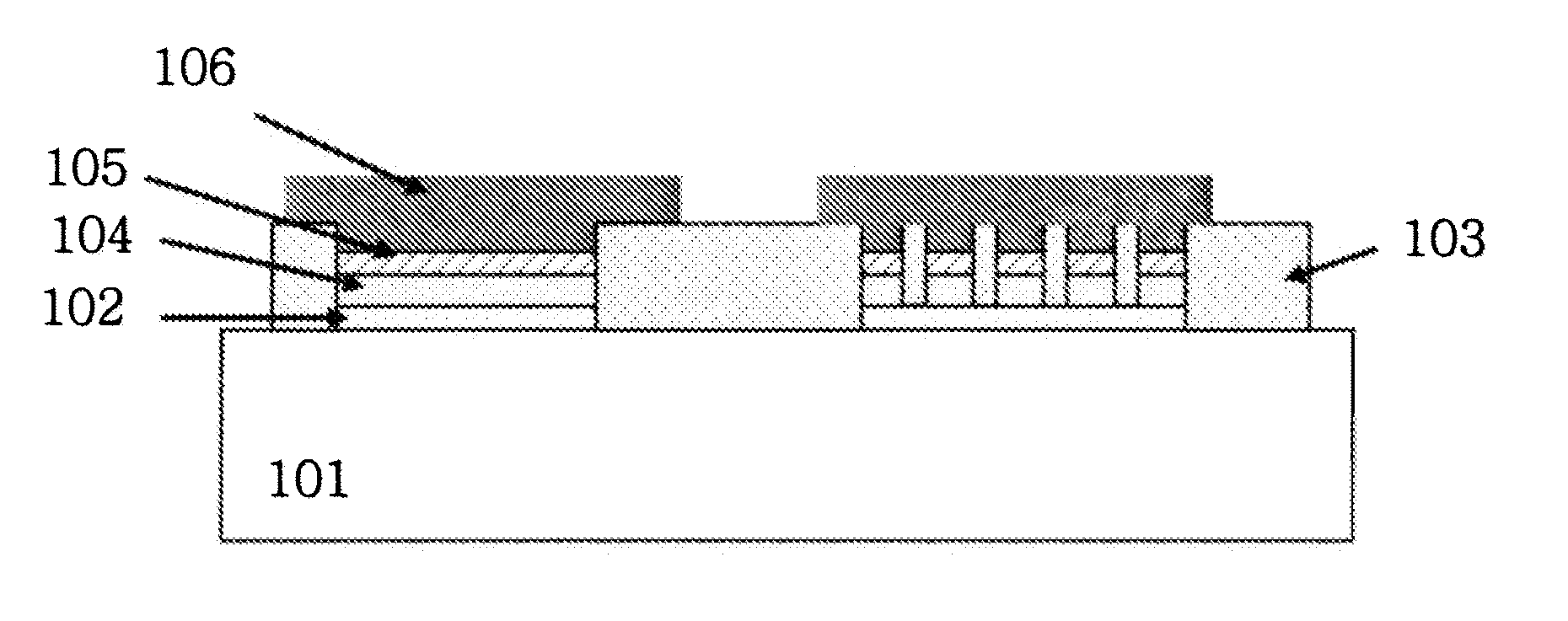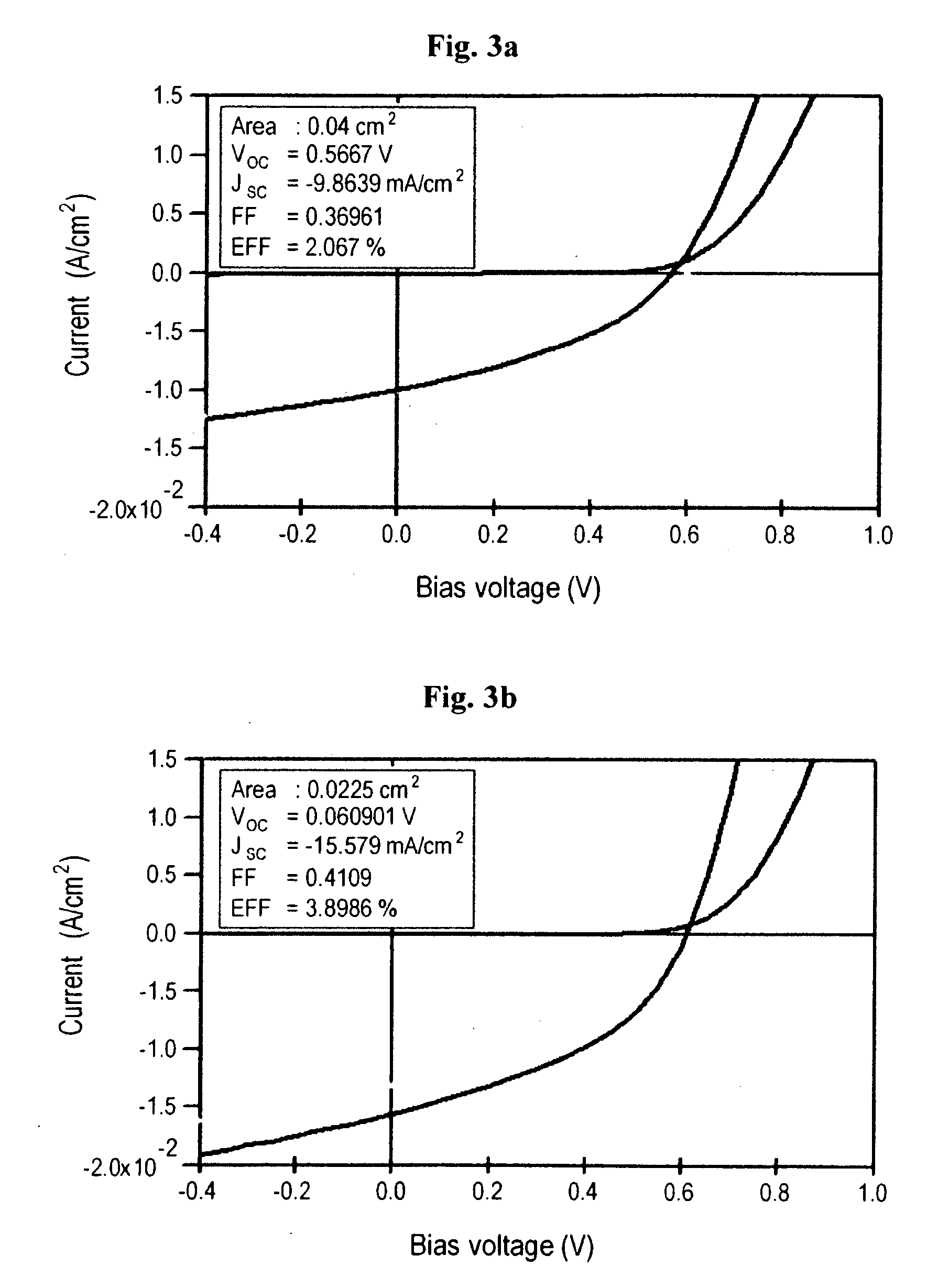Organic Photovoltaic Device With Improved Power Conversion Efficiency And Method Of Manufacturing Same
- Summary
- Abstract
- Description
- Claims
- Application Information
AI Technical Summary
Benefits of technology
Problems solved by technology
Method used
Image
Examples
example 1
Fabrication of an Organic Photovoltaic Device by Active Area Partitioning
[0057]As illustrated in FIG. 2, the following process was carried out to fabricate a single device wherein both the small area of an organic photovoltaic device formed by active area partitioning with insulating partitioning walls introduced into the device according to the method of the present invention and the large area organic photovoltaic device formed according to the prior art method are formed thereon. At this time, the organic photovoltaic device was prepared by spin coating a P3HT / PCBM blend, which is the representative organic blend useful for forming a bicontinuous interpenetrating network structure, on a transparent electrode, and depositing aluminum as an electrical charge extraction electrode thereon. When a single large area cell with no partitioning wall and a plurality of small area subcells including partitioning walls are formed in a single device like this, it is possible to reduce errors ...
example 2
Characteristic Analysis of an Organic Photovoltaic Device
[0063]A current-voltage (I-V) characteristic of the organic photovoltaic device fabricated in Example 1 was measured by using a Keithley 2400 source-measure unit. The results are shown in FIGS. 3a and 3b. At this time, a Xe lamp (300 W) was used as a light source. Further, the strength of light was regulated by using an air mass filter (AM 1.5, Oriel) under the illumination condition of imitating an irradiation wavelength of sunlight, in combination with the use of a neutral density filter if necessary. The strength of light irradiation was measured by using a calibrated broadband optical power meter (Spectra Physics model 404).
[0064]As shown in FIG. 3a, the open circuit voltage of the organic photovoltaic device fabricated according to the prior art method was 0.56697 V, the short circuit current density thereof was 9.8639 mA / cm2, the fill factor thereof was 0.36961, and the power conversion efficiency thereof was 2.067%. On ...
example 3
Change in Power Conversion Efficiency Depending on Conductivity of an Electrode Protection Layer
[0065]In order to examine the effect of a correlation between conductivity of an electrode protection layer and active area partitioning on power conversion efficiency in the organic photovoltaic device according to the present invention, the electrode protection layer was formed by using Baytron A1 4083 (Bayer) having a conductivity of 10−3 S / cm instead of using the Baytron P layer having a conductivity of 1 S / cm. Except for using Baytron A1 4083 as an electrode protection layer, the organic photovoltaic device through active area partitioning according to the method as described in Example 1 and the organic photovoltaic device according to the prior art method were also fabricated in a single cell device. Their current-voltage characteristics were analyzed according to the same method as described in Example 2.
[0066]As a result, as can be seen in FIG. 4a, the organic photovoltaic device...
PUM
| Property | Measurement | Unit |
|---|---|---|
| Transparency | aaaaa | aaaaa |
| Power conversion efficiency | aaaaa | aaaaa |
| Electron affinity | aaaaa | aaaaa |
Abstract
Description
Claims
Application Information
 Login to View More
Login to View More - R&D
- Intellectual Property
- Life Sciences
- Materials
- Tech Scout
- Unparalleled Data Quality
- Higher Quality Content
- 60% Fewer Hallucinations
Browse by: Latest US Patents, China's latest patents, Technical Efficacy Thesaurus, Application Domain, Technology Topic, Popular Technical Reports.
© 2025 PatSnap. All rights reserved.Legal|Privacy policy|Modern Slavery Act Transparency Statement|Sitemap|About US| Contact US: help@patsnap.com



